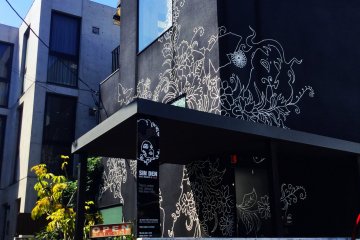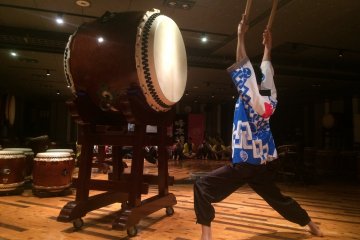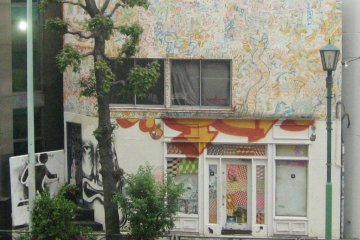A large, striped building by a zebra crossing on Gaien Nishi Dori houses the Watari Museum of Contemporary Art, or Watari-um. You might be forgiven for missing it as it’s not immediately obvious it’s an art gallery, and the ground floor is almost entirely devoted to a very lovely shop, with the ticket desk for the exhibition floors tucked away to the left as you enter the building. Have a look at the shop – it’s pricey but has a great selection of postcards, stationery and contemporary jewellery. There is also a café in the basement which is a good place to take a break for a while.
The current exhibition is called Turning Around and stretches over the 2nd, 3rd and 4th floors of the building. It is an eclectic, engaging collection of works by highly active, often guerrilla-style artists from all over the world. The four main artists / collectives whose work makes up the exhibition are Chim ↑Pom (who also curated the exhibition), JR, VOINA and AdBusters, with additional works by jamasyman, Kota Takeuchi, Iri and Toshi Maruki, The Yes Men, and Finger Pointing Worker. It’s a wild and crazy set of names, reflected in the wild and crazy nature of the works on display.
It does not matter where in the building you start looking at the exhibition so I would recommend you start on the 4th floor and work your way down, as the works build in intensity the lower you get.
The 4th floor is dominated by video installations by Chim ↑Pom and JR. The former is a collective of Japanese artists, whose work focuses on the aftermath of 2011’s devastating earthquake and tsunami. There are photos of the destroyed Fukushima reactors, and the disastrous effects on the coastal city of Soma. Next to these images, the French artist JR tackles some other major global issues through his street exhibitions of giant images of faces. He invites us to use art to “turn the world inside out”.
The 3rd floor looks at images that parody the media, with exhibits such as The Yes Men’s fake New York Times, 100,000 copies of which were distributed free in 2008. There is also a large selection of AdBusters magazines, whose work examines “the deception of political propaganda”. On this floor I was stopped in my tracks by three portraits by young Japanese artists Kota Takeuchi. I couldn’t work out where on earth I’d seen the faces before, until I read the accompanying explanation. In a comment on the way a society deals with fear and criminality, Takeuchi has reproduced images from Wanted Persons posters found in the local area. I pass several sets of these every day on the metro but hadn’t realised how much the faces had sunk into my own consciousness until I saw Takeuchi’s work.
The 2nd floor is, in my opinion, visually the most gripping, with giant images by Russian collective VOINA of their public protests against the state (group sex in the Timirayazev State Museum of Biology; overturning police cars containing drunk officers) greeting you as you enter. There are also cute but slightly weird models of Pikachu, which you subsequently find out are black rats caught in Shibuya, and ‘reshaped’ to look like the Pokémon character. Round the corner you are confronted by a shattered glass arrow that has taken a nosedive into the ground, and a huge burnt section of wall that was actually set alight in the gallery. It’s a massive emergency exit sign, out of which the man has run and can be seen trying to get into a building across the street.
With its 1000 yen entrance fee Turning Around is not cheap, but once you’ve paid once you can return to the exhibition as many times as you wish – just bring your ticket and some ID with you. Turning Around asks more questions than it answers but it is consistent in its refusal to accept the status quo, and fairly brutally requesting the visitor to confront their own ideas about what’s going on in the world at the moment. It’s not a relaxing exhibition but it’s highly worth seeing if you want something to make you think.











